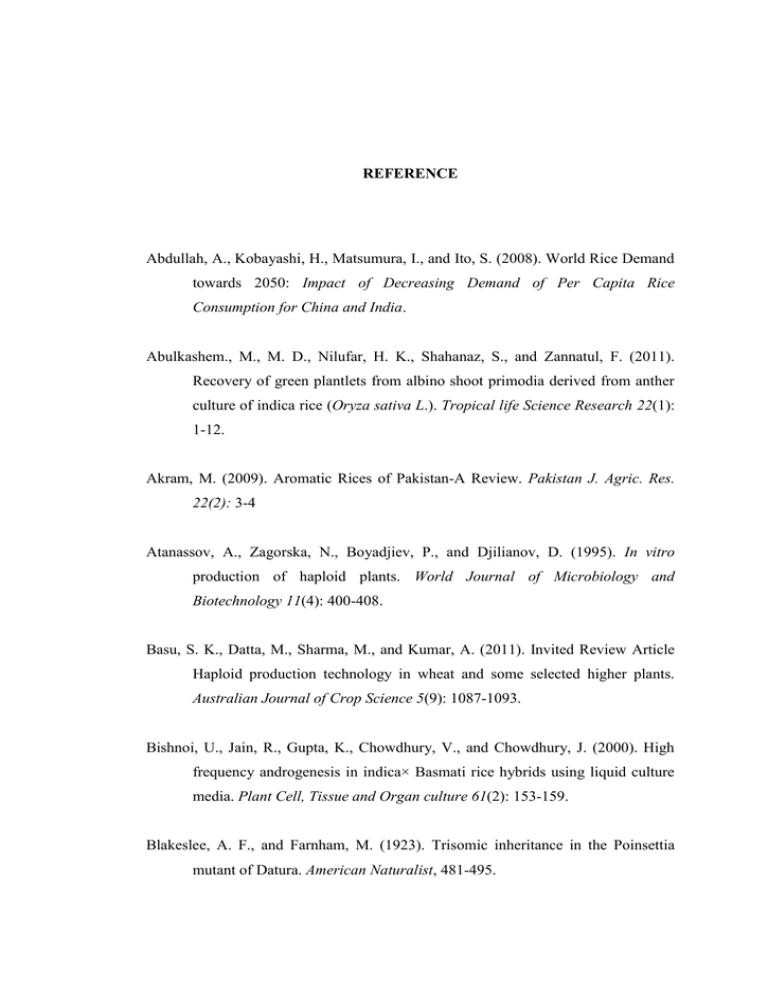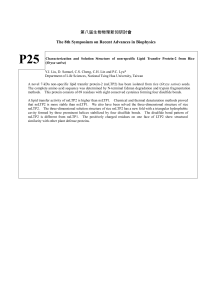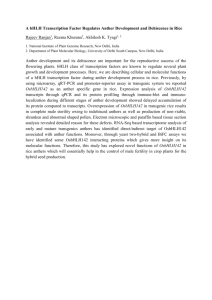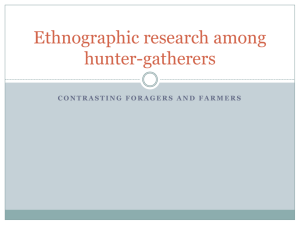REFERENCE Abdullah, A., Kobayashi, H., Matsumura, I., and Ito, S
advertisement

REFERENCE Abdullah, A., Kobayashi, H., Matsumura, I., and Ito, S. (2008). World Rice Demand towards 2050: Impact of Decreasing Demand of Per Capita Rice Consumption for China and India. Abulkashem., M., M. D., Nilufar, H. K., Shahanaz, S., and Zannatul, F. (2011). Recovery of green plantlets from albino shoot primodia derived from anther culture of indica rice (Oryza sativa L.). Tropical life Science Research 22(1): 1-12. Akram, M. (2009). Aromatic Rices of Pakistan-A Review. Pakistan J. Agric. Res. 22(2): 3-4 Atanassov, A., Zagorska, N., Boyadjiev, P., and Djilianov, D. (1995). In vitro production of haploid plants. World Journal of Microbiology and Biotechnology 11(4): 400-408. Basu, S. K., Datta, M., Sharma, M., and Kumar, A. (2011). Invited Review Article Haploid production technology in wheat and some selected higher plants. Australian Journal of Crop Science 5(9): 1087-1093. Bishnoi, U., Jain, R., Gupta, K., Chowdhury, V., and Chowdhury, J. (2000). High frequency androgenesis in indica× Basmati rice hybrids using liquid culture media. Plant Cell, Tissue and Organ culture 61(2): 153-159. Blakeslee, A. F., and Farnham, M. (1923). Trisomic inheritance in the Poinsettia mutant of Datura. American Naturalist, 481-495. 66 Bhojwani, S. S., and Razdan, M. K. (1996). Plant Tissue Culture: Theory and Practice (2): 185-187. Bhattacharjee, P., Singhal, R. S., and Kulkarni, P. R. (2002). Basmati rice: a review. International journal of food science & technology 37 (1): 1-12. Cha-um, S., Srianan, B., Pichakum, A., and Kirdmanee, C. (2009). An efficient procedure for embryogenic callus induction and double haploid plant regeneration through anther culture of Thai aromatic rice (Oryza sativa L. subsp. indica). In Vitro Cellular & Developmental Biology-Plant 45(2): 171179. Chaleff, R. (1982). Induction, maintenance, and differentiation of rice callus cultures on ammonium as sole nitrogen source. Plant Cell, Tissue and Organ culture 2(1): 29-37. Chen, Q., Wang, C., Lu, Y., Shen, M., Afza, R., Duren, M., and Brunner, H. (2001). Anther culture in connection with induced mutations for rice improvement. Euphytica 120(3): 401-408. Chu, C. C. (1978). The N6 medium and its applications to anther culture of cereal crops. Paper presented at the Proceedings of Symposium on Plant Tissue Culture. Cho, M., and Zapata, F. (1988). Callus formation and plant regeneration in isolated pollen culture of rice (Oryza sativa L. cv. Taipei 309). Plant Science 58(2): 239-244. Chu, C. (1997). The N6 medium and its applications to anther culture of cereal crops. ProcSymp Plant Tissue Culture. Science Press, Peking 37(4): 43-50. Datta, S. K. (2005). Androgenic haploids: Factors controlling development and its application in crop. Current Science 89(11): 56-64 67 Don Palmer, C., and Keller, W. A. (2005). Overview of haploidy. Haploids in Crop Improvement II, 3-9. Dunwell, Jm (1986). Pollen, ovule and embryo culture as tools in plant breeding, Butterworths, London. 375. Dewia, I. S., and Purwokob, B. S. (2008). Role of polyamines in inhibition of ethylene biosynthesis and their effects on rice anther culture development. Indones J Agric Sci 9(2): 60-67. Faruque, M. O., Farzana, T., Seraj, Z. I., Sarker, R., and Khatun, A. (1998). Variations in green plant regeneration response from anthers of indica rice and their hybrids with japonica cv. Taipei 309. Plant Cell, Tissue and Organ culture, 54(3), 191-195. Germanà, M. A. (2011). Anther culture for haploid and doubled haploid production.Plant Cell, Tissue and Organ culture 104(3): 283-300. Guha, S., and Maheshwari, S. (1964). In vitro production of embryos from anthers of Datura. Nature, 204, 497. Gioi, T. D., and Tuan, V. D. (2002). Effect of different media and genotypes on anther culture efficiency of F1 plants derived from crosses between IR64 and new plant type rice cultivars. Omonrice. 10, 107-109. Grewal, D., Gill, R., and Gosal, S. (2006). The role of cysteine in enhancing androgenesis and regeneration of indica rice (Oryza sativa L.). Plant growth regulation 49(1): 43-47. Gueye, T., and Ndoye, K. (2010). In vitro production of double haploid plants from two rice species (Oryza sativa L. and Oryza glaberrima Steudt.) for the rapid development of new breeding material. Scientific Research and Essays, 5(7): 709-713. 68 Guo, H. F., and Junwen, O. (1988). The effects of KNO3 concentration in callus induction for wheat anther culture. Plant Cell, Tissue and Organ culture 12(2): 3-12. Gupta, H., and Borthakur, D. (1987). Improved rate of callus induction from rice anther culture following microscopic staging of microspores in iron alumhaematoxylin. Theoretical and Applied Genetics, 74(1): 95-99. Hussain, Z., Khan, M. H., Bano, R., Rashid, H., and Chaudhry, Z. (2010). Protocol optimization for efficient callus induction and regeneration in three Pakistani rice cultivars.Pak. J. Bot 42(2): 879-887. Herath, H., Bandara, D., and Samarajeewa, P. (2010). Effect of culture media for anther culture of indica rice varieties and hybrids of indica and japonica. Tropical Agricultural Research and Extension 10(2): 17-22. Heberle-Bors, E. (1985). In vitro haploid formation from pollen: a critical review. Theoretical and Applied Genetics 71 (3): 361-374. He, T., Yang, Y., Tu, S., Yu, M., & Li, X. (2006). Selection of interspecific hybrids for anther culture of indica rice. Plant Cell, Tissue and Organ culture 86(2): 271-277. Heberle-Bors, E. (1985). In vitro haploid formation from pollen: a critical review. Theoretical and Applied Genetics 71(3): 361-374. Ivanova, M., and Van Staden, J. (2009). Nitrogen source, concentration, and NH 4 + : NO3- ratio influence shoot regeneration and hyperhydricity in tissue cultured Aloe polyphylla. Plant Cell, Tissue and Organ culture 99(2): 167-174. Javed, M. A., Ishii, T., Kamijima, O., and Misoo, S. (2007). The role of alternating culture temperatures and maltose in enhancing the anther culture efficiency of salt tolerant indica rice (Oryza sativa L.) cultivars, Pokkali and Nona Bokra. Plant biotechnology 24(3): 283-287. 69 Kasha, K. J. (2005). Chromosome doubling and recovery of doubled haploid plants. Haploids in Crop Improvement II, 123-152. Küpper, H., Lombi, E., Zhao, F. J., & McGrath, S. P. (2000). Cellular compartmentation of cadmium and zinc in relation to other elements in the hyperaccumulator Arabidopsis halleri. Planta 212(1): 75-84. Kumria, R., Waie, B., andRajam, M. (2001). Plant regeneration from transformed embryogenic callus of an eliteindica rice via agrobacterium. Plant Cell, Tissue and Organ culture 67(1): 63-71. Lentini, Z., Reyes, P., Martínez, C. P., and Roca, W. M. (1995). Androgenesis of highly recalcitrant rice genotypes with maltose and silver nitrate. Plant Science 110(1): 127-138. Lee, K. W., Chinzorig, O., Choi, G. J., Kim, K. Y., Ji, H. C., Park, H. S., Lee, S. H. (2012). Factors influencing callus induction and plant regeneration of Dahurian wildrye grass (Elymus dahuricus L.). African Journal of Biotechnology 11(4): 815-820. Davey, R., M., and Anthony, P (2010). Plant Cell Culture. Loughborough, UK: A. John Wiley and Sons, Ltd. Mott, R.,L. Cordts, J.,M. and Larson, A.,M. (1985). Nitrogen and growth regulator effects on shoot and root growth of soybean in vitro in Henke R.R., Hughes, K.W., Constantin M.J., Hollaender A.A. and Wilson C.M. (eds.) Tissue Culture in Forestry and Agriculture. Plenum Press, New York, London, pp. 336-337. Miah, M., Earle, E., and Khush, G. (1985). Inheritance of callus formation ability in anther cultures of rice, Oryza sativa L. Theoretical and Applied Genetics 70(2): 113-116. 70 Niizeki, H. (1968). Induction of haploid plant from anther culture. Jap. Agr. Res. Quart 3(3): 41-45. Ogawa, T., Fukuoka, H., and Ohkawa, Y. (1995). Plant regeneration through direct culture of isolated pollen grain in rice. Breed Sci 45(2): 301-307. Purwoko, B. S., Dewi, I. S., and Khumaida, N. (2007). Rice anther culture to obtain Doubled-Haploids with Multiple Tolerances. Paper presented at the Proceedings Asia Pacific Conference on Plant Tissue and Agribiotechnology (APaCPA). Pande, H. (1997). Androgenesis in anther cultures of an indica cultivar of Oryza sativa L. PhD Thesis, University of Delhi. Qi, Y., Ye, Y., and Bao, M. (2011). Establishment of plant regeneration system from anther culture of Tagetespatula. Afr. J. Biotechno, 10(75): 17332-17338. Razdan, M. K. (2003). Introduction to plant tissue culture.Science Pub Incorporated. media. Plant Cell, Tissue and Organ culture 61(2): 153-159. Rafique, M. Z., Rashid, H., Chaudhary, M., Chaudhry, Z., and Cheema, N. (2011). Study on callogenesis and organogenesis in local cultivars of rice (Oryza sativa L.). Pak. J. Bot 43(1): 191-203. Raina, S., and Zapata, F. (1997). Enhanced anther culture efficiency of indica rice (Oryza sativa L.) through modification of the culture media. Plant breeding 116(4): 305-315. Raina, S., and Irfan, S. (1998). High-frequency embryogenesis and plantlet regeneration from isolated microspores of indica rice. Plant Cell Reports 17(12): 957-962. 71 Razdan, M. K. (2003). Introduction to plant tissue culture. Science Pub Incorporated. Shahnewaz, S., and Bari, M. A. (2004). Effect of Concentration of Sucrose on the Frequency of Callus Induction and Plant Regeneration in anther culture of rice (Oryza sativa L.). Plant Tissue Cult 14(1): 37-43. Silva, T., and Ratnayake, W. (2009). Another culture potential of indica rice varieties, KURULU THUDA and BG 250. Tropical Agricultural Research. Saleem, M. Y. (2008). GENETIC ANALYSIS OF BASMATI RICE (Oryza sativa L.). Pak. J. Bot 42(1): 627-637. Saleem, M. Y., Mirza, J. I., andHaq, M. A. (2010). Combining ability analysis for yield and related traits in basmati rice (Oryza sativa L.). Pak. J. Bot 42(1): 627-637. Seguí-Simarro, J. M. (2010). Androgenesis revisited. The Botanical Review 76(3): 377-404. Sen, C., and Singh, R. (2011). Anther Culture Response in Boro Rice Hybrids. Asian Journal of Biotechnology 3(5): 470-477. Sripichitt, P., Ozawa, T., Otani, M., and Shimada, T. (2000). Improved method for anther culture of an indica rice cultivar of Thailand. Plant production science 3(3): 254-256. Sunderland, N. (1978). Strategies in the improvement of yields in anther culture. In: ProcSymp Plant Tissue Culture. Science Press, Peking 45(4): 65–86. Song, H., Li, S., Li, G., Yun, S., and Li, J. (1978). Studies of increasing the induction rate of callus tissue and pollen plants from anthers of Oryza sativa cultured in vitro. Proc Syrup Plant Tissue Culture. Science Press, Peking, 97. 72 Tasy, H., S. (1981). Effects of nitrogen supply to donor plants on pollen embryogenesis in cultured tobacco anthers. J Agric Res China 30(1): 5-13. Torp, A., and Andersen, S. (2009). Albinism in microspore culture. Advances in Haploid Production in Higher Plants, 155-160. Vasil, I. K., (1988). Androgenic haploids. Int Rev Cytol Suppl 11(1):195–223. Xie, J., Gao, M., Cai, Q., Cheng, X., Shen, Y., & Liang, Z. (1995). Improved isolated microspore culture efficiency in medium with maltose and optimized growth regulator combination in japonica rice (Oryza sativa). Plant Cell, Tissue and Organ culture 42(3): 245-250. Yan, J., Xue, Q., and Zhu, J. (1996). Genetic studies of anther culture ability in rice (Oryza sativa). Plant Cell, Tissue and Organ culture 45(3): 253-258. Zhang, C., and Qifeng, C. (1993). Genetic studies of rice (Oryza sativa L.) anther culture response. Plant Cell, Tissue and Organ culture 34(2): 177-182.


